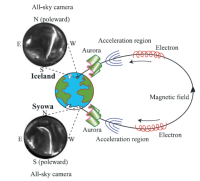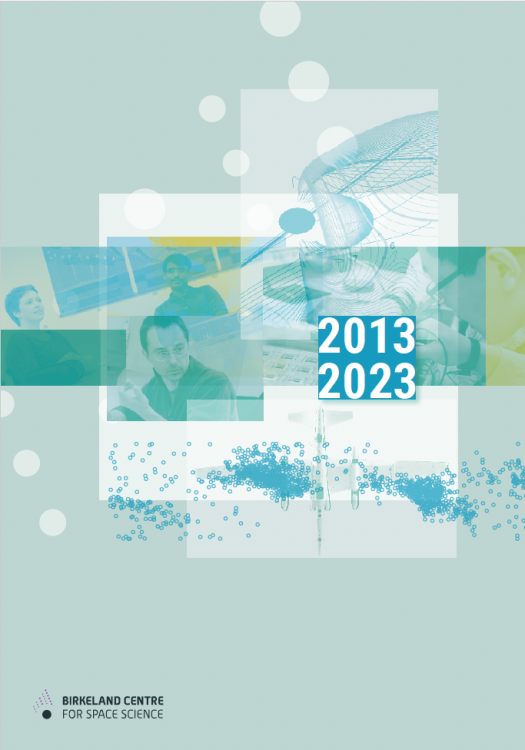IPY-ICESTAR
Background
Data & Instruments
Research
Publications
The Norwegian IPY-ICESTAR program is part of the IPY ID63: “Heliosphere Impact on Geospace”
Main objectives
- How various constituents of the magnetosphere-ionosphere system respond to geomagnetic disturbances under different heliospheric conditions. This will be achieved by studying:
-Interhemispherical studies from space and ground.
-Middle atmosphere chemistry changes induced by energetic particle precipitation - Continous radar measurements by the EISCAT Svalbard Radar throughout the Polar Year
With the IPY open data policy these data will be freely accessable for the international community and also be used as a main data base for our own scientific studies - Public Outreach and Education
-The Space Suitecase
-Conference on Space Science for Norwegian journalists
EISCAT Svalbard Radar
A main effort of the Norwegian IPY-ICESTAR effort is to run the EISCAT Svalbard radar continously throughout the polar year, starting March 1, 2007. With the open data policy, these data will be accessable for the international community through the MADRIGAL database.
Imaging from Space
Imaging data from the IMAGE and Polar mission will be used in this study. The IMAGE FUV system and the Polar VIS Earth Camera provided simultaneous conjugate UV images of similar emissions suitable for comaparing studies. Short intervals of conjugate data can be found from 2000-2005.
– IMAGE FUV system
– Polar VIS Earth Camera
Optics and riometer from Ground
GAIA is a set of tools for browsing / obtaining summary data from All Sky Imagers, Photometer, and Riometers around the world. We are currently in the development stage.
– GAIA
The Auroral Optical Network provides ASC images
Magnetometers from ground
Magnetometers and ASC data: MIRACLE
Papitashvilis VGMO: VGMO
Antarctic data: PENGUIN
The SuperDARN chain
With coverage in both hemispheres this HF radar network is an important database for the IPY-ICESTAR project: SuperDARN
Ionospheric tomography chains: IITC
The scientific goals of the Norwegian ICESTAR/IHY Program are closely linked to the international ICESTAR Program and will focus on Inter-hemispherical Studies of magnetosphere-ionosphere coupling the heliospheric drivers and the effects of geomagnetic disturbances in the mesosphere and stratosphere.

The overall objective of the program is to assess
- how the various constituents of the magnetosphere-ionosphere system repond to geomagnetic disturbances under different heliospheric conditions, and
- how these disturbances interact with the polar upper and middle atmosphere.
We will determine
- the timing and location of substorm onsets in the two hemispheres.
- the conjugacy or non-conjugacy of theta aurora to obtain information about structure and dynamics of the closed magnetosphere during positive z – component of the interplanetary magnetic field.
- the magnetic reconnection rates (dayside and nightside) to clarify the energy/mass exchange with the solar wind.
- the interaction with the middle atmosphere by use of satellite and ground-based observations of minor constituents in the middle atmosphere, and measures of energetic particle precipitation (EPP) to further develop models of the EPP-induced chemical changes, in particular with regard to nitrogen species.

An O-shaped aurora seen from ground.
We will obtain new knowledge about interaction between magnetosphere and ionosphere by radar observation of ion outflow and related fine scale ionospheric structures and plasma physics, and also from observations of conductance, convection patterns, polar cap potentials and field aligned currents in the two hemispheres.
- A. Keiling, K. Shiokawa, V. Uritsky, V. Sergeev, E. Zesta, L. Kepko, and N. Østgaard, Auroral Signatures of the Dynamic Plasma Sheet, AGU monograph, ‘Relationship between Auroral Phenomenology and Magnetospheric Processes’, in press.
- N. Østgaard and K. M. Laundal, Auroral asymmetries in the conjugate hemispheres and interhemispheric currents, AGU monograph, ‘Relationship between Auroral Phenomenology and Magnetospheric Processes’, #2011BK001190, in press.
- N. Østgaard, K. M. Laundal, L. Juusola , A. Aasnes, S. E. Haaland, J. M. Weygand. Interhemispherical asymmetry of substorm onset locations and the Interplanetary Magnetic Field. Geophys. Res. Lett., Vol. 38, L08104, doi:10.1029/2011GL046767
- N. Østgaard, B. K. Humberset, K. M. Laundal, Evolution of auroral asymmetries in the conjugate hemispheres during two substorms, Geophys. Res. Lett., Vol. 38, No. L03101, doi:10.1029/2010GL046057
- K. M. Laundal, N. Østgaard, H. U. Frey, J. Weygand. Seasonal and IMF dependent polar cap contraction during substorm expansion phase J. Geophys. Res. , Vol. 115, A11224, doi:10.1029/2010JA015910
- K. M. Laundal, N. Østgaard, K. Snekvik, H. U. Frey. Inter-hemispheric observations of emerging polar cap asymmetries J. Geophys. Res., Vol. 115, No. A7, A07230, doi: 10.1029/2009JA015160
- H. U. Frey, O. Amm, C. C. Chaston, S. Fu, G. Haerendel, L. Juusola , T. Karlsson, B. Lanchester, R. Nakamura, N. Østgaard, T. Sakanoi, E. Seran , D. Whiter, J. Weygand. Small and Meso-scale Properties of a Substorm Onset Auroral Arc. J. Geophys. Res. Vol. 115, A10209, doi:10.1029/2010JA015537
- Orsolini, Y.J., J. Urban, D. Murtagh, S. Lossow and V. Limpasuvan, Descent from the polar mesosphere and anomalously high stratopause observed in 8 years of water vapor and temperature satellite observations by the Odin Submillimeter Radiometer, J. Geophys. Res., 115, D12305, doi:10.1029/2009JD013501, 2010
- K. M. Laundal and N. Østgaard, Asymmetric auroral intensities in the Earth’s Northern and Southern hemispheres.
Nature Letters, Vol. 460, doi:10.1038/nature08154, 2009.
paper from the nature site
the cover at nature site - Urban, J., D. Murtagh, M. Pommier, M. Santee, Y.J. Orsolini:, Nitric acid in the stratosphere based on Odin observations from 2001 to 2009- part 1: A global climatology, Atmos. Chem. Phys., 9, 7031-7044, 2009
- Orsolini, Y.J., J. Urban, and D. Murtagh, Nitric acid in the stratosphere based on Odin observations from 2001 to 2009- part 2: High-altitude polar enhancements, Atmos. Chem. Phys., 9, 7045-7052, 2009
- K. Olafsson, N. Østgaard, and E. Tanskanen, The Space Science Suitcase – Instruments for Exploring Near-Earth Space from the Classroom, Earth Moon Planet, 104, page 73-75, doi: 10.1007/s11038-008-9261-z
- E. I. Tanskanen, A comprehensive high-throughput analysis of substorms observed by IMAGE magnetometer network: years 1993 – 2003 examined, accepted, JGR, 2008.
- Huttunen, K.E.J., Kilpua, S.P., Pulkkinen A., Tanskanen, E. Solar wind drivers of large geomagnetically induced currents during the solar cycle 23, Space Weather, Vol 6, doi:10.1029/2007SW000374
- Laundal K. M., N. Østgaard (2008), Persistent global proton aurora caused by high solar wind dynamic pressure, J. Geophys. Res., 113, A08231, doi:10.1029/2008JA013147.
- N. Østgaard, S. B. Mende, H. U. Frey, J. B. Sigwarth, A. Aasnes, J. Weygand, Auroral conjugacy studies based on global imaging JASTP, special issue from Yosemite 2006, 69, 249-255, 2007.
- N. Østgaard , S. B. Mende, H. U. Frey, J. B. Sigwarth, A. Aasnes, J. Weygand, Conjugate imaging of substorms, Proceedings from the ICS 8, 2006, in Banff, Canada, ISBN 978-0-88953-312-7, 2007.
- Pulkkinen, T.I., Palmroth, M., TANSKANEN, E.I., Ganushkina, N.Y., Shukhtina, M.A., Dmitrieva, N.P., Solar wind \u2013 magnetosphere coupling: A review of recent results, Journal of Atmospheric and Solar-Terrestrial Physics, Vol 69, Issue 3, 256-264, 2007.
- J. Sojka, R. Schunk, T. van Eyken, J. Kelly, C. Heinselman, M. McCready, Ionospheric Challenges of the International Polar Year, EOS, Transaction, American Geophysical Union, Vol. 88, NO. 15, Page 171, 2007




